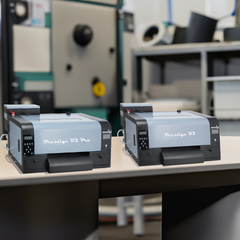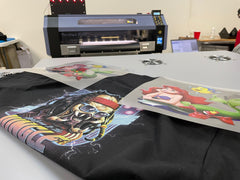Everyone who does DTG printing are always looking to improve their prints and workflow process.
Lawson understands the complex and technical side of improving DTG t-shirt printing. Having helped DTG printers scale up their operations and maximize production workflow, there is both a science and art to producing the best DTG prints. Below are some helpful tips and tricks for getting on your way to printing high quality designs on garments.
Document everything: The most successful direct-to-garment printers can repeat a job, whether it was 1 month ago, or 1 year ago. This means being able to recall the exact same settings and parameters, including RIP settings, color density, and amount of pretreat solution used. Make a system for documenting your work. Writing it down on paper is helpful, but consider keeping this information in an electronic file, such as Excel, Word or, a Google Doc.
Use Quality Garments: Direct-To-Garment printing works best with 100% cotton shirts. Look for garments that are high quality and “ring spun.” A t-shirt that is of lower quality might result in a less than desirable print.
Some DTG printers have had success with 50/50 and tri-blend material garments. Those that are making it work have done significant testing prior to offering it to their customers. If you are going to offer these garment options to your customers, test your prints on these fabrics first. During testing, you want to check both for color brilliance and wash fastness.
Printing on polyester is still something that all DTG printers are searching for. At the moment, the issue is not whether you can actually print on polyester, since we know you can, but the concern is wash fastness. By nature, polyester material is designed to repel water and be resistant to “stains.” DTG ink is water-based, so when printing on poly garments, the garment thinks it is being “stained” by the ink and reacts by trying to prevent it.
This natural “reaction” of repelling the ink does not show up during printing. It manifests itself during washing. The DTG ink does not adhere to the polyester fibers and comes off during washing. Epson's Polyester Pre-Treat does allow for DTG printing on 100% polyester garments. However, due to the nature of the polyester weave, the prints look different when compared to DTG printing on cotton.
Quality Control Check: Make sure you perform quality control tests on your direct-to-garment prints. This is especially true with setting up a new process, or getting ready to start offering a new type or style of shirt. Some of the key things to test are: 1) various amounts of pretreatment fluid, 2) pretreat and ink curing times and 3) printer settings. It is also very important to incorporate wash tests into your QC check. You will want to wash and dry different DTG printed garments to ensure wash fastness and see if the color fades in the wash.
A part of this quality control check is to help you decide what options your clients have. For instance, many screen printers are comfortable printing on certain Gildan t-shirts that are notoriously difficult for DTG printing. By testing this type of shirt, you will know what the customer should expect. Being able to either let them know what to expect, or by simply not offering this particular garment is powerful information to have. Testing garments and different techniques will let you know whether that service is something you should offer.
Pretreat Properly: This goes back to testing and quality control and documenting everything. Make sure your pretreat machine settings are right as this forms the base of quality DTG printing. You want between 28-32 grams of pretreat solution for the average T-shirt. One “pro tip” for pretreating your garments is to use a heat press for about 5-7 seconds prior to printing. This smoothes out wrinkles, removes any moisture in the garment, and creates a smooth printing surface.
Watch this brief video on how to Weigh Your Pretreat Solution
Curing: DTG production shops all use conveyor dryers. It allows for faster production times, both for curing pretreat solution and curing DTG ink. There are a lot of great conveyor dryers available available for DTG. One of the most important factors in choosing a dryer for DTG printing is the amount of CFM (cubic feet per minute). Since DTG ink is water-based, removing moisture is key to a quick and thoroughly dried garment. Dryers that produces a high amount of CFM will dry shirts quicker and better
Perform Required Maintenance: It cannot be overstated that the required maintenance must be performed to keep your DTG printer in the best condition. Missing even a day or two can have big consequences on printing quality and the ability of your printer to function at peak performance.
Your DTG machine likes a clean and comfortable environment. This includes being in a climate controlled area with an average amount of humidity. Invest in a temperature gauge with a humidity display. Seeing this information always on display is a helpful reminder.

High Quality Artwork is Key: Use only high-quality artwork. Sometimes you might have to explain to your customer what that means and why an iPhone picture might not produce a good DTG print. Click to read a Related Article: Getting Art Files Ready for Print
These are just some helpful tips that you can learn from large production DTG print shops and start using in your shop today. Try implementing them into your own shop for better DTG production.




